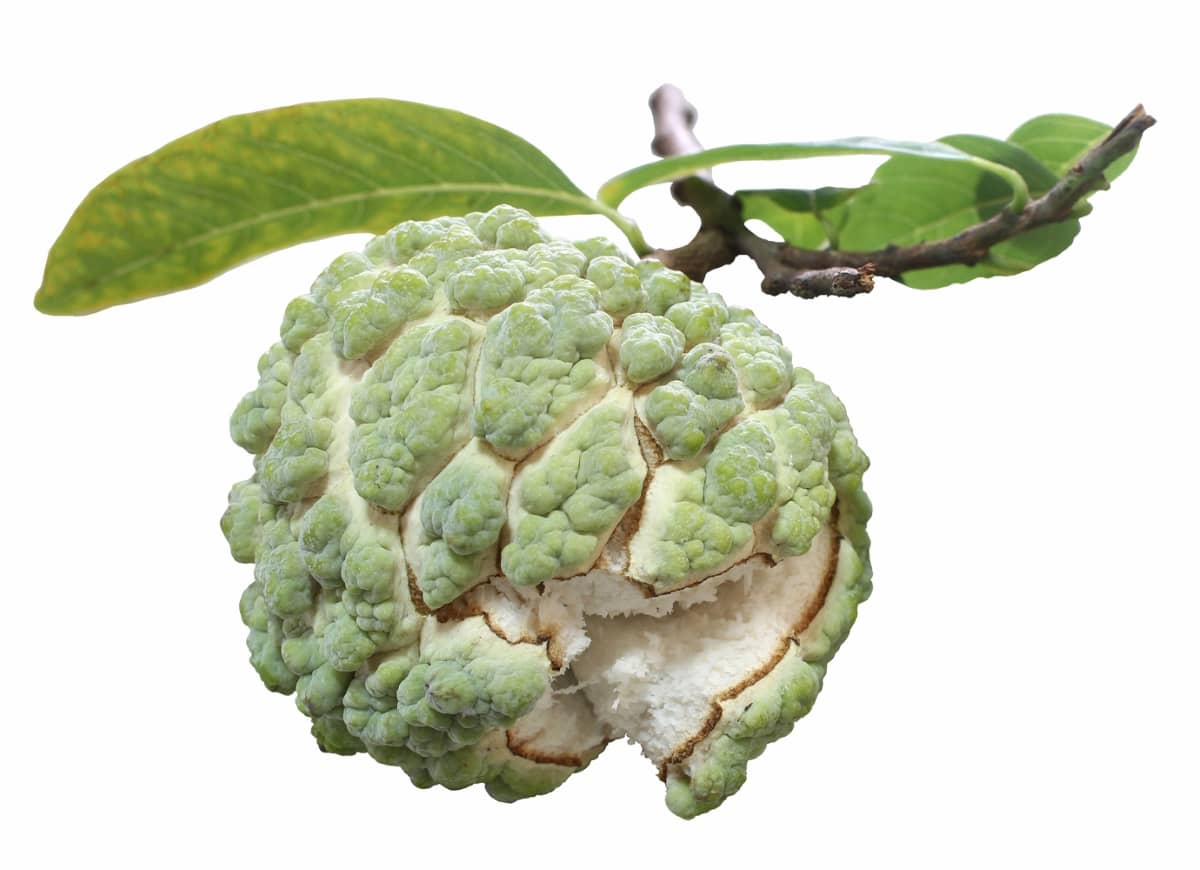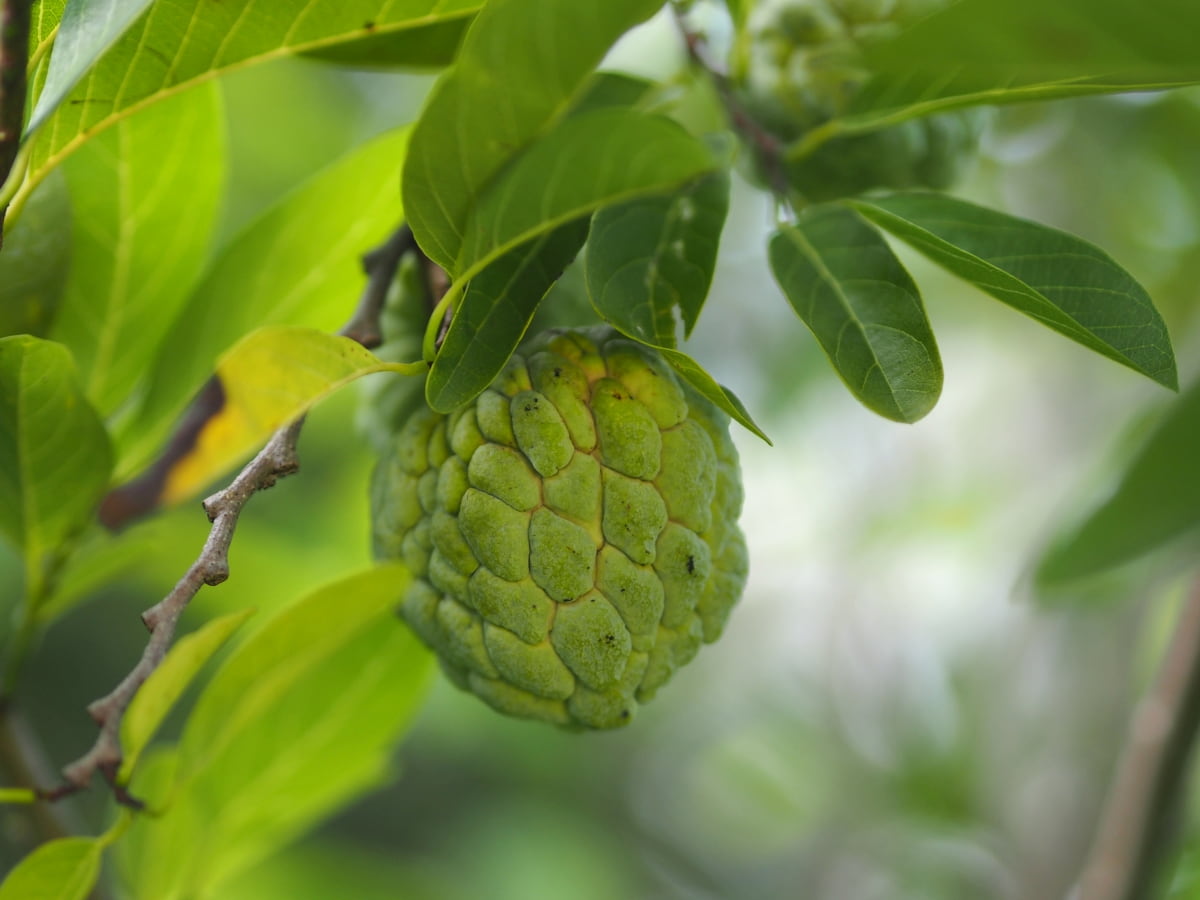This guide aims to protect your custard apple orchard from fruit rot, a perennial issue that can compromise its vitality. It explores the causes of fruit rot and provides effective, natural, and organic treatments to ensure the orchard’s sustained health, not just protect a harvest.

How to Prevent Custard Apple Fruit Rot Naturally
Understanding Custard Apple Fruit Rot
Custard apple fruit rot is a disease that can severely damage orchard yields if left unchecked. Botryosphaeria dothidea and Colletotrichum gloeosporioides, two fungi that thrive in warm, humid environments, are the cause of it. Understanding these fungi’s lifecycle is crucial for developing effective preventive strategies. Custard apples are prime targets for infection due to their susceptibility. To protect them, orchardists should adopt a multi-faceted approach, including optimizing orchard hygiene, proper tree spacing, and using organic fungicides and biological controls.
Causes of Custard Apple Fruit Rot
- Environmental Havoc: Custard apple fruit rot thrives in a hotbed of high humidity and warm temperatures, creating a perfect storm for fungal spores. These conditions trigger a domino effect, paving the way for fruit rot to take hold.
- Irrigation Quandary: The way we water matters. Overhead watering, a common practice, backfires by showering leaves with moisture, a playground for fungal mischief. Opting for drip irrigation is the smart move, reducing leaf wetness and thwarting the fungal fiesta.
- Tool Trouble: It’s not just the weather; tools can be stealthy culprits, too. Contaminated equipment, like pruning tools or harvest gear, acts as a courier for fungal spores. Regular cleaning of these tools is the superhero move to halt the spread.
Importance of Natural and Organic Treatment
Organic and natural treatments are crucial for the long-term health of custard apple orchards and consumers. Synthetic chemicals pose a risk to the ecosystem and humans consuming the fruit, while organic treatments minimize ecological impact and support sustainable agriculture. These treatments promote a healthy microbial community, improve soil health, and satisfy consumer demand for pesticide-free produce.
Organic custard apples are not only delicious but also free of hazardous chemical residues. Using natural and organic treatments is an investment in the resilience of the orchard, the earth’s health, and the satisfaction of environmentally conscious customers.
Cultural Practices for Preventing Custard Apple Fruit Rot
- Strategic Tree Spacing: Ensure adequate space between custard apple trees, promoting air circulation. This minimizes humidity, creating an environment less favorable for fruit rot-inducing fungi.
- Regular Pruning: Embrace a routine pruning schedule to eliminate crowded or diseased branches. This practice not only enhances sunlight penetration but also reduces the risk of fungal proliferation.
- Removal of Infected Plant Material: Promptly remove any signs of infection, including diseased fruits or leaves. This curtails the spread of pathogens within the orchard, preventing further contamination.
- Optimizing Orchard Hygiene: Maintain cleanliness by regularly clearing fallen leaves and debris. This reduces the potential reservoirs for fungal spores, impeding their ability to thrive and propagate.
- Enhanced Air Circulation: Foster an orchard environment that facilitates air movement. Proper spacing and pruning contribute to improved airflow, creating an inhospitable setting for fruit rot pathogens.
In case you missed it: Fertilizing Potted Custard Apple Trees: Organic, Natural, Homemade, NPK, and Schedule

Beneficial Insects and Biological Control Methods
Biological control is a sustainable and eco-friendly pest management method that involves introducing beneficial organisms like nematodes and parasitic wasps into an orchard. These insects act as guardians, controlling pest populations without the need for harmful chemicals. Parasitic wasps lay their eggs inside harmful pests, disrupting their lifecycle and minimizing damage to custard apple fruit.
Nematodes, microscopic warriors, attack soil-dwelling pests, releasing bacteria that eliminate them without harming the trees. Ladybugs, voracious predators, are introduced into the orchard as a visually appealing method of controlling pest populations.
Organic Fungicides for Custard Apple Fruit Rot Control
Organic fungicides are a sustainable and eco-friendly solution for custard apple fruit rot, offering a safe alternative to synthetic chemicals. Copper-based fungicides like copper hydroxide and copper sulfate disrupt fungal cell membranes and inhibit spore germination without leaving harmful residues.
Neem oil, extracted from the neem seeds, has natural antifungal properties and impeds fungi growth and reproduction. Potassium bicarbonate creates an alkaline environment on the fruit surface, hindering fungal development. These green solutions not only combat fruit rot but also promote orchard health, meeting the growing demand for organic produce and contributing to a sustainable agricultural future.
Proper Irrigation and Drainage Techniques
- Effective Irrigation: Ensuring orchards receive the right amount of water is crucial. Drip irrigation, a targeted method, delivers water directly to the root zone, minimizing leaf wetness and reducing the risk of fungal diseases.
- Say No to Overhead Watering: Overhead irrigation might seem convenient, but it creates a moisture-laden environment on leaves, promoting fungal growth. Opting for drip or soaker hoses helps keep leaves dry, safeguarding against diseases like fruit rot.
- Optimal Soil Moisture: Orchards thrive with consistent soil moisture. Mulching helps retain moisture, while regular monitoring ensures orchards receive adequate water without becoming waterlogged.
- Strategic Drainage: Preventing waterlogged conditions is essential. Well-drained soil encourages root health and reduces the risk of root rot, a common issue in waterlogged environments.
Mulching and Soil Amendments for Disease Prevention
Mulching protects the soil by controlling moisture, suppressing weeds, and adjusting temperature. Organic mulches like wood chips and straw create a barrier that protects custard apples from soil-borne diseases. This promotes a healthier root environment in addition to preventing pathogens from pouring onto the fruit.
In case you missed it: How to Pollinate Custard Apple Trees: Hand Pollination, Natural Pollination Methods, and Tips

Adding organic matter improves soil structure and fosters the growth of a healthy microbial population. This community suppresses disease by acting as a natural defense. Orchardists strengthen their custard apple orchards by using mulching and soil additives, which not only create a disease-resistant environment but also enhance the general health and vitality of the soil.
Monitoring and Early Detection of Fruit Rot Symptoms
- Visual Inspections: Regularly inspect custard apple orchards for dark lesions on fruit surfaces or oozing sap. These are early indicators of potential fruit rot.
- Scheduled Walkthroughs: Conduct systematic orchard walkthroughs, especially during peak infection periods. Focus on areas prone to humidity and warmth, where fungal spores thrive.
- Record-keeping: Maintain a simple record of observed symptoms. This helps track changes over time and aids in predicting potential outbreaks.
- Use of Diagnostic Tools: Employ user-friendly diagnostic tools, such as magnifying lenses, to examine fruit surfaces for subtle signs of infection closely.
- Education and Training: Provide orchard staff with basic training on identifying common symptoms. An informed team enhances the collective effort in monitoring and early detection.
Integrated Pest Management Strategies for Custard Apple Fruit Rot Prevention
- Holistic Approach: Integrated Pest Management (IPM) is a comprehensive strategy blending various methods to tackle custard apple fruit rot. It’s like orchestrating a symphony of defenses against fungal adversaries.
- Cultural Practices: Start by optimizing orchard hygiene, proper spacing between trees, and strategic pruning. This creates an environment that’s less appealing to fruit rot-causing fungi.
- Beneficial Insects: Introduce nature’s defenders – ladybugs, predatory mites – to feast on pests contributing to fruit rot, creating a natural balance.
- Organic Fungicides: Copper-based solutions, neem oil, and potassium bicarbonate disrupt the fungi’s lifecycle organically, leaving custard apples unscathed.
- Monitoring and Early Detection: Regular inspections for symptoms like dark lesions or sap ooze allow for swift intervention, minimizing the impact on harvest.
- Adaptive Strategies: Tailor your IPM plan to your orchard’s unique conditions, ensuring a proactive and sustainable defense against fruit rot.
Frequently Asked Questions (FAQ) on Apple Fruit Rot
Are Certain Apple Varieties More Susceptible to Fruit Rot?
Yes, some apple varieties are more susceptible to fruit rot than others. Varieties with thin skin and softer flesh are usually more vulnerable. It is advisable to choose disease-resistant apple cultivars when planting to minimize the risk of fruit rot.
Can Apple Fruit Rot Spread to Other Healthy Apples?
Yes, apple fruit rot can spread to healthy apples. As a result of the rot spreading within the tree and to nearby apples, fungal spores can travel by wind, insects, or water. Prompt treatment and removal of infected fruits can help prevent the spread.
In case you missed it: Project Report of 1-Acre Custard Apple Farming: Cultivation Cost and Profit Analysis

Conclusion
Preventing custard apple fruit rot is a strategic process in orchard stewardship. By understanding its causes, embracing natural and organic treatments, and adopting a holistic approach to care, you can fortify your orchard against fruit rot, ensuring a thriving orchard where custard apples thrive without disease shadows.
- Ultimate Guide to Ossabaw Island Hog: Breeding, Raising, Diet, and Care
- Ultimate Guide to Juliana Pig: Raising Facts, Size, Diet, Care, and Lifespan
- Raising Lleyn Sheep: Disadvantages, Price, Uses, Characteristics, and Care
- Ultimate Guide to Meishan Pig: Breed Facts, Breeding, Raising, and Care
- Ultimate Guide to Teacup Pigs: Raising, Diet, Lifespan, Cost, and Care
- Guide to Raising Poll Dorset Sheep: Facts, Profile, Characteristics, Uses, and Care
- Ultimate Guide to Bighorn Sheep: Characteristics, Diet, Lifespan, Breeding, and Lifecycle
- Ultimate Guide to Raising Katahdin Sheep: Farming Facts, Breed Profile, Uses, and Care
- Ultimate Guide to Raising Oreo Cows: Belted Galloways Farming Facts, Profile, Uses, and Care